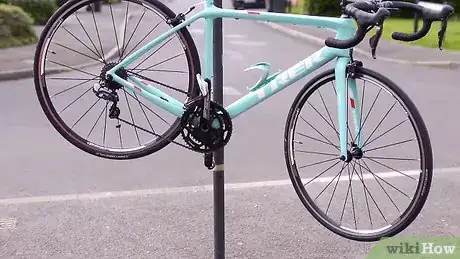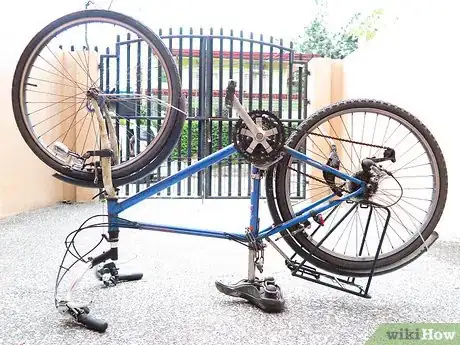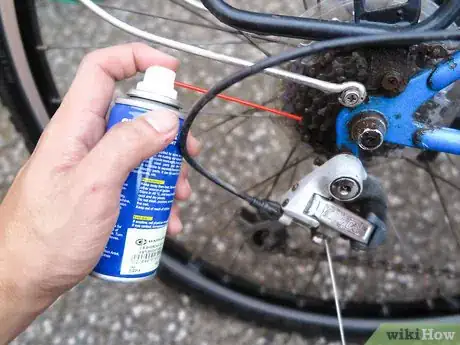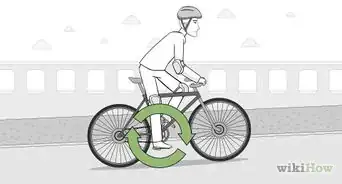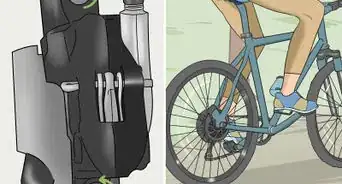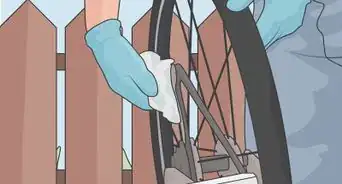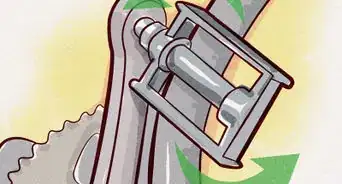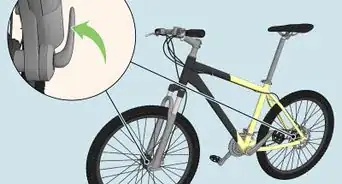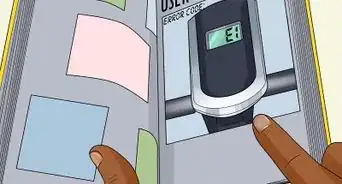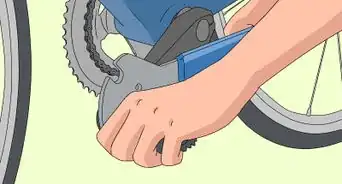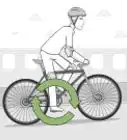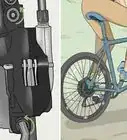wikiHow is a “wiki,” similar to Wikipedia, which means that many of our articles are co-written by multiple authors. To create this article, 34 people, some anonymous, worked to edit and improve it over time.
There are 7 references cited in this article, which can be found at the bottom of the page.
wikiHow marks an article as reader-approved once it receives enough positive feedback. In this case, 90% of readers who voted found the article helpful, earning it our reader-approved status.
This article has been viewed 229,460 times.
Learn more...
Clean bicycles not only look nice, but they also work better and go faster. Regular washings will keep your bike free from costly repairs or damage due to rust or corrosion, and it only takes 10-15 minutes to do it properly.
Steps
Cleaning the Drivetrain
-
1Always clean your drivetrain, which propels the bike, first. The drivetrain is the transmission of your bike. It is made up of four parts: a cassette (collection of gears on your back wheel), a rear derailleur (metal arm on the back wheel), chain rings (big gears next to your pedals), and the chain. The drivetrain gets you moving, but as dirt, rust, and grime add up you become more prone to skipping and chain issues.
- Frequent cleaning and maintenance of your drive train can add years to your bike's working lifespan.[1]
-
2Elevate the bike or turn it over so that you can pedal without the bike moving. You will need to get the chain moving on the bike to clean it properly. If you don't have a bike stand, flip the bike over on the seat and handlebars. Be sure to put a towel or rag that you don't mind getting dirty underneath the bike to avoid scuffing the seat or handles.Advertisement
-
3Use a rag and biodegreaser to scrub the chain. Biodegreaser, otherwise known as biodegradable solvent, cuts through grime like soap but won't ruin or gum up your chain. You can find it at most bike stores, near the lubricant. Pour a little bit on your rag and clamp it over the chain, lightly enough that the chain can still freely move between your fingers. Pedal the bike with your other hand, running the chain for 2-3 cycles.[2]
- Run the chain through the rag 2-3 more times, placing pressure lightly with your fingers on the top, bottom, and both sides of the chain.
- Knock off any patches of grease or grime with your rag if they are still visible.
-
4Use an old scrubbing brush or toothbrush to clean between your gears. Gears need to be flossed to keep grime and dirt out of the cassette. Dip your brush into a mixture of water and biodegradable solvent and run it between each set of gears. If it is easier, hold the brush in place while you pedal with the other hand.
- Use a screwdriver or pick to knock off built-up deposits from hard to reach areas.
-
5Wipe away grime on the outside of the derailleur and chain rings. If it looks dirty, it's got to go. Use your damp rag, brush, and a little degreaser to get into as many nooks and crannies as you can and make your bike sparkling clean. Let the wheels do the work whenever possible by keeping the rag/brush in place and spinning the pedals. Commonly forgotten areas include:
- The jockey wheels, the small cogs on the derailleur arm that need cleaning too.
- The backside (closest to the bike) of the chain rings.
- The bike frame, joints, and hinges near the chain.
-
6Purchase a chain cleaner for extremely grimy chains. If a rag and a toothbrush don't cut it, you may need to buy a chain cleaning tool.You add degreaser to the box and clamp it over your chain. You can then hold the tool in place while pedaling the bike, which brushes and scrubs the chain links for you. They are usually $20-$30 and come with degreaser and a brush for hard to reach areas.
-
7Lube your bike chain immediately after cleaning it. No matter how often you bike, you should always have a bottle of chain lube handy, which should both lubricate the chain and protect it from dirt and moisture. Slowly turn the pedals after cleaning and drying everything. Apply a single drop of lube to every 2-4 links, where one link meets another. Once you've hit the whole chain, shift through your gears and apply another 10-12 drops to make sure everything, cassette included, has a nice even coating. Use your rag to wipe up any excess lube from the chain when you are done, as extra lube can hold dirt and lead to grime. If you are going to clean the rest of your bike as well, wait and do this at the very end.
- Your goal is a light coating of lube on the entire chain, not to drench it in lube. It should light coat your fingers if you touch the chain.
- Feel the chain with your fingers -- if it feels dry then you need to apply more lube.
- Never use WD-40 on a bike chain -- it is not made for the weather or stress.
Cleaning Your Frame and Wheels
-
1Rest the bike in a stand, on a rack, against a tree, or upside down. Lay a mat or old sheet down on the ground to protect the seat and bars from dirt and scuff marks if you've turned it upside down. Make sure you are in an open, well-ventilated area that can get wet without ruining anything.
-
2Spray down the bike with a low-pressure hose. You don't want to blast any of the dirt away, you simply want to wet the bike and remove and loose dirt and grime before you start scrubbing.
- Never use a high-pressure hose or nozzle setting. This can force water into your components, causing internal rusting or de-lubricating important junctions.[3]
-
3Fill up a bucket with warm water. If you desire, you can also add a bike specific cleaner, but avoid using ordinary dish soap as it typically contains salt which can corrode parts of the bike, including the frame. You will want to use a different bucket and sponge than the ones used for your drivetrain. Grease from the chain and cassette will get on your frame if you don't use fresh supplies, ruining your clean-up job.
-
4Remove your wheels. You want to get into those as much as possible and you need to get on the inside of the frame with your sponge. The wheels make it difficult to clean the parts of the bike closest to the ground and tire, which are often the dirtiest areas.
-
5Use the soft side of a sponge to clean the frame. Scrub up and down the entire frame, which is the metal body of the bike, with a sponge and warm water. Never use a rough or abrasive brush on your frame, even with persistent stains. This can scratch your paint off and make the bike prone to rusting.
- If there is a particularly tricky bit of grime, apply a small drop of soap or degreaser onto the spot with some water and let it soak for several minutes. Methodically scrub, in a circular motion, until you get it removed.
- If you have caliper breaks (two black pads which pinch the top of the wheel), use the rough side of the sponge to remove any crud build up on them.
- If you have disc brakes (attached metal disc to the wheels), wipe down both sides with the soft side of the sponge.[4]
-
6Wipe down the rims of your wheels. The tires, which will become dirty again the second they touch the road, do not need to be cleaned. But the metal rim of the wheel can pick up gunk that gets in the way of your breaks. Use the abrasive side of a sponge to clean off the edges and lightly wipe down each spoke so your bike looks clean and sparkly.
- Use a toothbrush to scrub the hub-- the small cylinder in the center of the wheel -- and the nuts and bolts on either side of it.
- If you want to clean your tires, or you see large chunks of mud in the treads, use a big, heavy bristled brush (like the one sold with a dust pan)[5] to clean them quickly and painlessly.
-
7Use a clean rag to get deep into your rear cassette. The rear cassette is the collection of gears on the back of the bike. While you cleaned it briefly when you cleaned the drivetrain, you should take the time to make sure it is spotless when doing a full bike cleaning. Drip some soapy water into the cassette, then use a clean rag to "floss" in between each of the gears and remove any extra gunk built up deep in the cassette.
-
8Lightly pat everything dry and let the bike sit in the sun and open air. You don't want water sitting around and pooling in your components. Take a clean, dry rag or towel and wipe up excess water. Focus on the joints and components -- anywhere where water could presumably sit for a long time. When you're done, put the bike back together and let it air dry, preferably in the sun.
- If you were resting the bike on its saddle and bars, wipe these downs when you flip the bike back over before you start drying everything.
- If you're cleaning your bike on a damp or cloudy day, take a little more time drying everything off.
Keeping Your Bike Clean
-
1Know that regular bike cleanings will increase the life of your bike. Bikes are made up of screws, pulleys, nuts, bolts, and cables, all of which need to function smoothly to keep you riding. Rust, dirt, and missing lubrication will cause your components to grind up against one another, increasing wear and tear and preventing you from a smooth ride. Being proactive about bike cleanings can save you a lot of time and money later on.
- Wiping down your bike with a damp cloth after a dirty or muddy ride now can save you a lot of time and hassle doing a "deep" clean.
-
2Perform a "quick clean" after any wet or rainy rides. Dry off your bike as best you can with a towel or clean rag and check the chain. Water and mud can get into your cassette and chain and cause major problems later on, but they are easiest to remove right after the ride. Pat down the chain and wipe away any dirt in the rings and derailleurs, then add 4-5 drops of added lubrication to make up for any that washed away.
- Check you chain -- if it feels dry, take the time to do a full lubrication.
-
3Add 1-2 drops of bike lubricant to important components 2-3 times a year or after a deep cleaning. Your chain isn't the only part of the bike that needs to stay lubed up to work well. While they don't need nearly as much lubricant to run smoothly, the following parts could use a short squirt of lube to run well.
- Pivot points on your breaks, usually the part that holds the two sides together (caliper breaks only).
- Use your fingers or a small rag to coat the cables in a thin layer of lube.
- The shifters, if exposed. Make sure you only use bike lubricant.[6]
-
4Keep a close eye on your drivetrain. There are very few areas that get as dirty as a drivetrain, but this is probably the single most important area to keep clean. If you ride your bike daily a weekly or bi-weekly cleaning for your chain, cassette, and derailleurs is likely necessary.
- You will likely need to clean your drivetrain more often than the rest of the bike. At the very least you should check, clean, and potentially lube the chain every 1-2 weeks.[7]
-
5Clean your bike regularly to protect it from rust and damage. You should wipe down and clean your bike monthly, at a minimum. A good benchmark is to go through a cleaning after every 20-25 rides or so. You can then perform a deep clean and re-lubricate everything 1-2 a year. That said, there are sometimes you should always clean off your bike--
- After a very wet and muddy ride.
- When you hear squeaking or rubbing.
- Whenever you see dirt, grease, or grime in the joints, brakes, gears, or chain.[8]
Community Q&A
-
QuestionHow frequently should I do this to my bike?
 RubixGamerHDCommunity AnswerYou should wash your bike regularly if you use it frequently. If you're going to be keeping it in storage for a while, though, it's not necessary to keep washing it. The best times to wash your bike are when you come back from cycling on muddy trails or when you notice dirt starting to build up in places on your bike.
RubixGamerHDCommunity AnswerYou should wash your bike regularly if you use it frequently. If you're going to be keeping it in storage for a while, though, it's not necessary to keep washing it. The best times to wash your bike are when you come back from cycling on muddy trails or when you notice dirt starting to build up in places on your bike. -
QuestionHow do I wash my bike without getting your seat wet?
 Community AnswerCover the bike seat with a waterproof covering. A carrier bag or rubbish bag tied around the seat are both cheap and good candidates for the job. You can also remove the bike seat if you have the skills and tools to do so.
Community AnswerCover the bike seat with a waterproof covering. A carrier bag or rubbish bag tied around the seat are both cheap and good candidates for the job. You can also remove the bike seat if you have the skills and tools to do so. -
QuestionMy daughter's child sized bike has front brakes that aren't gripping well (not due to dirt on the rim). How do I clean this area?
 Community AnswerIt may not be a matter of cleaning; the brakes may simply need to be tightened. If there's no visible debris getting in the way of the brake pads, and you haven't accidentally gotten lube on them, that's the most likely cause.
Community AnswerIt may not be a matter of cleaning; the brakes may simply need to be tightened. If there's no visible debris getting in the way of the brake pads, and you haven't accidentally gotten lube on them, that's the most likely cause.
Warnings
- Only use bicycle lube on a bike, not automotive or WD-40.⧼thumbs_response⧽
- Do not spray the bike with high pressured water, it will wash away grease and lubricants that your bike needs. It may also intrude into areas where you do not want water intrusion like the hubs and pedal housing.⧼thumbs_response⧽
Things You'll Need
- Bucket of soapy water.
- Sponges
- Bike Stand
- Garden hose or clean water bucket
- Rags and/or towels
- Scrub brush
- Chain lubricant
- Clean drying towel.
- Degreaser
References
- ↑ http://www.rei.com/learn/expert-advice/bike-chain.html
- ↑ https://www.bikemaine.org/resources/bike-maintenance/
- ↑ http://www.bicycling.com/maintenance/bike-washing/how-wash-your-bike
- ↑ http://bicyclehabitat.com/how-to/how-to-wash-your-bike-pg363.htm
- ↑ http://www.bicycling.com/maintenance/bike-washing/how-wash-your-bike
- ↑ http://www.bicycling.com/maintenance/bicycle-maintenance/where-use-bike-lubricant
- ↑ https://www.bikemaine.org/resources/bike-maintenance/
- ↑ http://www.rei.com/learn/expert-advice/bike-maintenance.html
- Videos provided by Leonard Lee
About This Article
To wash your bike, start by spraying it down with a low-pressure hose to remove any loose dirt. Then, fill a bucket with warm water, remove the wheels, and use a soft sponge to clean the frame. If you come across a stubborn spot of grime, apply a small drop of soap or degreaser to the area, let it soak for a few minutes, and then scrub it in a circular motion until it’s clean. Once you’re done with the frame, wipe down the rims of your wheels before allowing your bike to air dry. For more tips on how to clean the frame and wheels of your bicycle, keep reading!

